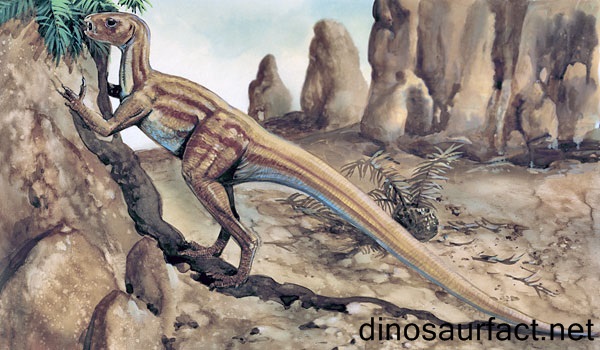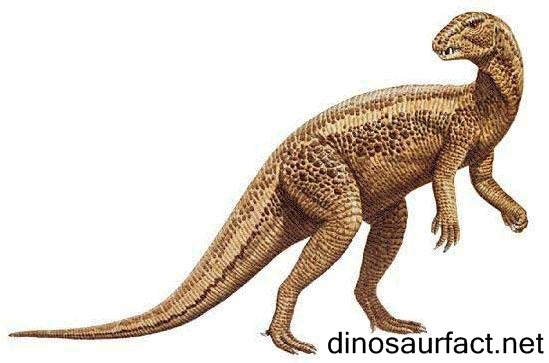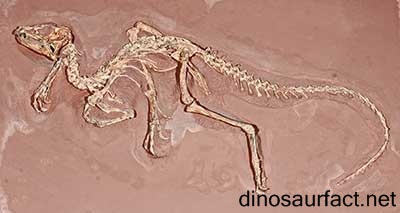 Click to visit the previous dinosaur bio
Click to visit the previous dinosaur bio
 |
|
 |
|
Kingdom: Animalia
Phylum: Chordata
Class: Sauropsida
SuperOrder: Dinosauria
Order: Ornithischia
Family: Heterodontosauridae
Genus: Heterodontosaurus
 |
|
 |
|
 |
|

Dinosaurs are believed to have evolved approximately 230 million years ago from the primitive archosaurs. Archosaurs were believed to be the rulers during the Mesozoic era however they were comparatively smaller than Dinosaurs . Dinosauria is a Greek word which means ‘fearfully great lizard’ and this was originally coined by Sir Richard Owen, a paleontologist of British Origin. These Dinosaurs have left their footprints on our planet and are still believed to be the most successful animals who have not only survived for ages but also formed and evolved themselves into diverse living habitats.
The Heterodontosaurus was a four feet long dinosaur and weighed around 20 kg and possess a very distinguishing feature that has a very debatable evolutionary significance. It had varied sets of teeth that came in different sizes. Something that is very uncommon in the Dinosaur fraternity. In the front were sharp teeth, followed by canine tusks and then grinding teeth that were more like chisels. They were characterized by a long narrow pelvis and a pubis which have a close resemblance to more advanced Ornithischians.
Heterodontosaurus was first discovered and described in 1962 by Alan J. Charig and Alfred W. Crompton at the Lower Jurassic Upper Red Beds of northern slopes of the Krommerspruit Mountain near Voisana located in South Africa. But it was only the head that was discovered then. However it was almost fifteen years later in 1976 that a full body well preserved fossil specimen was discovered and it had the look as if the saurus had died while in action. The juvenile Heterodontosaurus skull is currently kept in the collections of the Iziko South African Museum.
Iziko South African Museum
Detailed examinations of the skull suggests that the presence of developed teeth sets were not only restricted to males or females, in fact these were also found in the young specimens. This have dismissed the long believed idea that the teeth were specifically used by the males to fight off the other males in the territory. Rather scientists have now accepted that these teeth were in fact used for eating and defense.
Experts believe that dinosaurs had in general evolved from carnivorous ancestors. Heterodontosarus were among the earliest dinosaurs with a herbivorous habit and their teeth hence represents the transition between their carnivorous ancestors and the more sophisticated fully herbivore descendants. Fossil studies also indicate that juvenile Heterodontosaurus were having relatively large eyes and a shorter snout when compared to the adult form.
Studies suggest that the diet of the youngsters were very much like that of the adults. Experts suggest that with the help of strong forelimbs and sharp canine teeth the little Dinosaurs fed on roots. They used their five fingered hands to dig them up and their canine teeth to break the root open.
X-rays and CT scans have also pointed out a new mystery. A lack of replacement teeth have been observed in both juvenile and adult Heterodontosaurus. It is the characteristic of most reptiles to continually replace their broken and worn out teeth with new ones. It has been observed in various dinosaur fossils also that size of the teeth varies with the age. Whereas it is a characteristic of the mammal to replace their teeth only once in their life span by replacement of both the upper and lower jaw into an efficient and tight fitting. Heterodontosaurus in fact were more similar to mammals though not specialized. They possess the mammalian features of variable shaped teeth, tight arrangement of the teeth along with late replacement of old and worn out teeth.
Heterodontosaurus had quite unusual fore-arms as they had five fingers among which two fingers opposed the other three. Experts believe they had the ability to pick up small things with one hand only. These reptile fossils date back to around 195 million years old.
The systematic classification of Heterodontosaurus was analyzed using restricted taxa sample. Ornithischian position has however been affirmed. Ornithischian dinosaurs are generally believed to be entirely plant-eaters and are represented by a variety of dinosaurs starting from the horned dinosaurs, the duck-billed dinosaurs to the armored dinosaurs. The best hypothesis however positions heterodontosauridae in basal positions (non-genasurian) but again there is inadequate information on proximate out-group anatomy and other complete details . Phylogenetic perspectives however suggests that they occupied a crucial position on ornithischian dinosaur evolution. These reptiles are systematically classified under the Order-Ornithischia, Family-Heterodontosauridae , Genus- Heterodontosaurus.
It should also be mentioned that Tianyulon , discovered in China possessed hollow feather-like structures . Heterodontosaurus however were proven to stop existing 60 million years earlier yet experts believe these two to be a close relative to each other. However they have been believed to be associated with the evolution of feathers in dinosaur history.
This dinosaur hadcheek pouches for storing food while chewing . Their front legs were however smaller than the back legs but were also very strong. They also had a very long and flexible tail. The Heterodontosaours have been in a dormant state of research as recent articles suggest as much not has been published since the 1970’s. A 1976 note however describes the anatomy of these dinosaurs from studying a complete skeleton. As far as paleozoology goes a complete skeleton and that too of a Dinosaur is nothing that common and hence these papers are as a matter of fact great importance to science.
Previous articles are however positioning the hetertodontosaurs in a late Triassic period rather than early Jurassic. Again recently however there has been a few studies on the detail of cranial anatomy of the Heterodonts. Experts review the paper on the Juvenile Cranial Anatomy to be good value and being quite informative. While the other paper focuses basically on morphology and cranial anatomy and is available in Zoological Journal of Linnaen Society through Wiley’s publication. This articles that have been published in 2011 have however been inspired by the notes as well as the illustrations of Alan Charig and were passed on to Lead author David Norman as Charig passed away in 1997. This hereby makes it a touching story behind a very important anatomical discussion.
Index
Extinct Profiles
 Triassic Dinosaurs
Triassic Dinosaurs Jurassic Dinosaurs
Jurassic Dinosaurs Cretaceous Dinosaurs
Cretaceous Dinosaurs Pterosaurs
Pterosaurs Marine Reptiles
Marine Reptiles Dinosaur Extinction
Dinosaur Extinction